Strategic Change Management for Hi-Tech Electronics: A Detailed Report
VerifiedAdded on 2021/05/31
|25
|7693
|58
Report
AI Summary
This report provides a comprehensive analysis of strategic change management, focusing on the case of Hi-Tech Electronics Pvt. Ltd., a multinational firm implementing an ERP business suite. It explores various change management models, including Kurt Lewin's three-stage model, Kotter's eight-step model, and the ADKAR model, discussing their relevance and application within organizations. The report also examines internal and external factors driving the need for strategic change, resource implications of not adapting, and strategies for stakeholder involvement, managing resistance, and communicating change programs. It offers insights into the importance of these models and strategies for achieving better organizational results in the current economic climate, emphasizing the significance of communication, stakeholder engagement, and reinforcement to ensure successful change implementation.
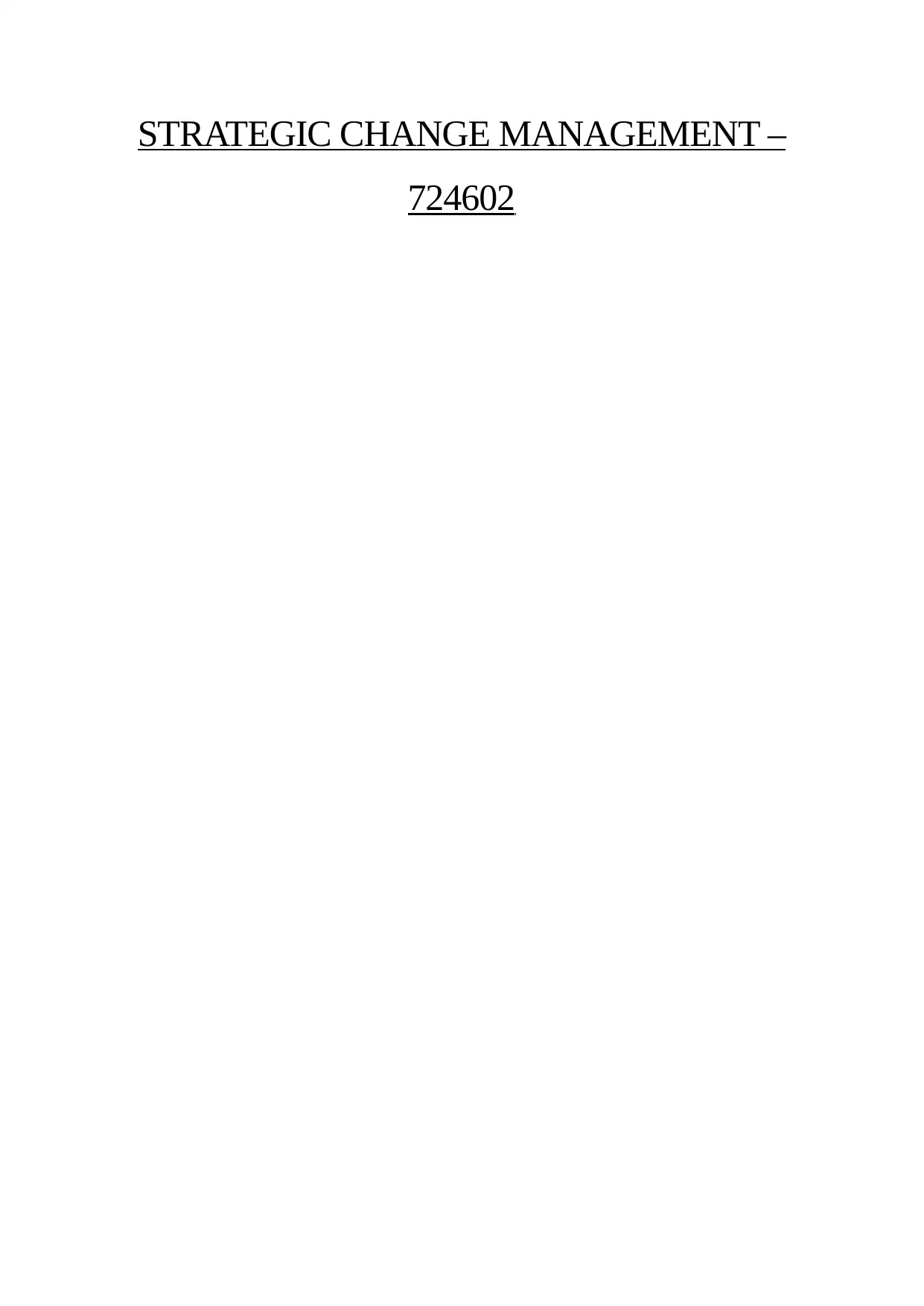
STRATEGIC CHANGE MANAGEMENT –
724602
724602
Paraphrase This Document
Need a fresh take? Get an instant paraphrase of this document with our AI Paraphraser
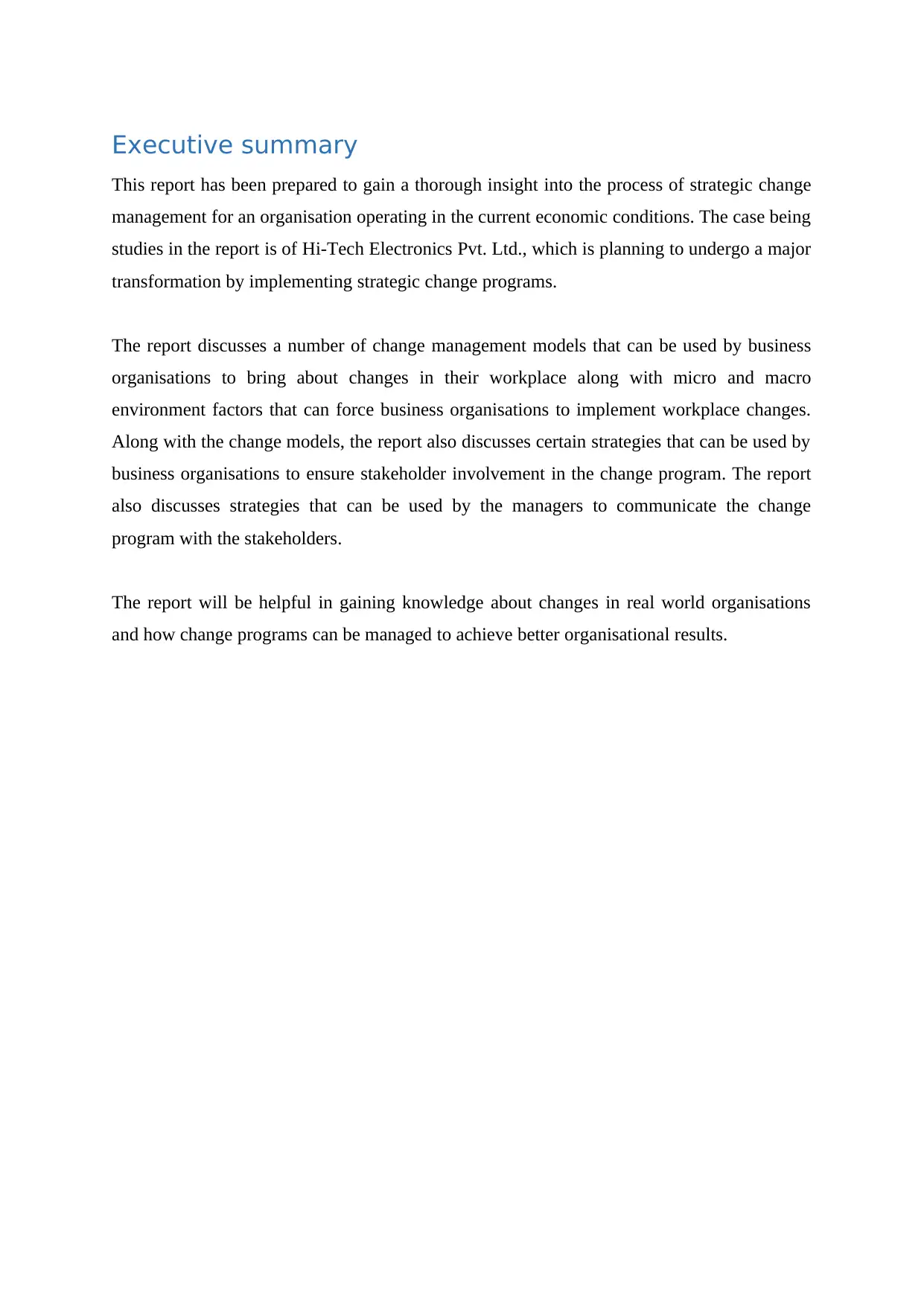
Executive summary
This report has been prepared to gain a thorough insight into the process of strategic change
management for an organisation operating in the current economic conditions. The case being
studies in the report is of Hi-Tech Electronics Pvt. Ltd., which is planning to undergo a major
transformation by implementing strategic change programs.
The report discusses a number of change management models that can be used by business
organisations to bring about changes in their workplace along with micro and macro
environment factors that can force business organisations to implement workplace changes.
Along with the change models, the report also discusses certain strategies that can be used by
business organisations to ensure stakeholder involvement in the change program. The report
also discusses strategies that can be used by the managers to communicate the change
program with the stakeholders.
The report will be helpful in gaining knowledge about changes in real world organisations
and how change programs can be managed to achieve better organisational results.
This report has been prepared to gain a thorough insight into the process of strategic change
management for an organisation operating in the current economic conditions. The case being
studies in the report is of Hi-Tech Electronics Pvt. Ltd., which is planning to undergo a major
transformation by implementing strategic change programs.
The report discusses a number of change management models that can be used by business
organisations to bring about changes in their workplace along with micro and macro
environment factors that can force business organisations to implement workplace changes.
Along with the change models, the report also discusses certain strategies that can be used by
business organisations to ensure stakeholder involvement in the change program. The report
also discusses strategies that can be used by the managers to communicate the change
program with the stakeholders.
The report will be helpful in gaining knowledge about changes in real world organisations
and how change programs can be managed to achieve better organisational results.
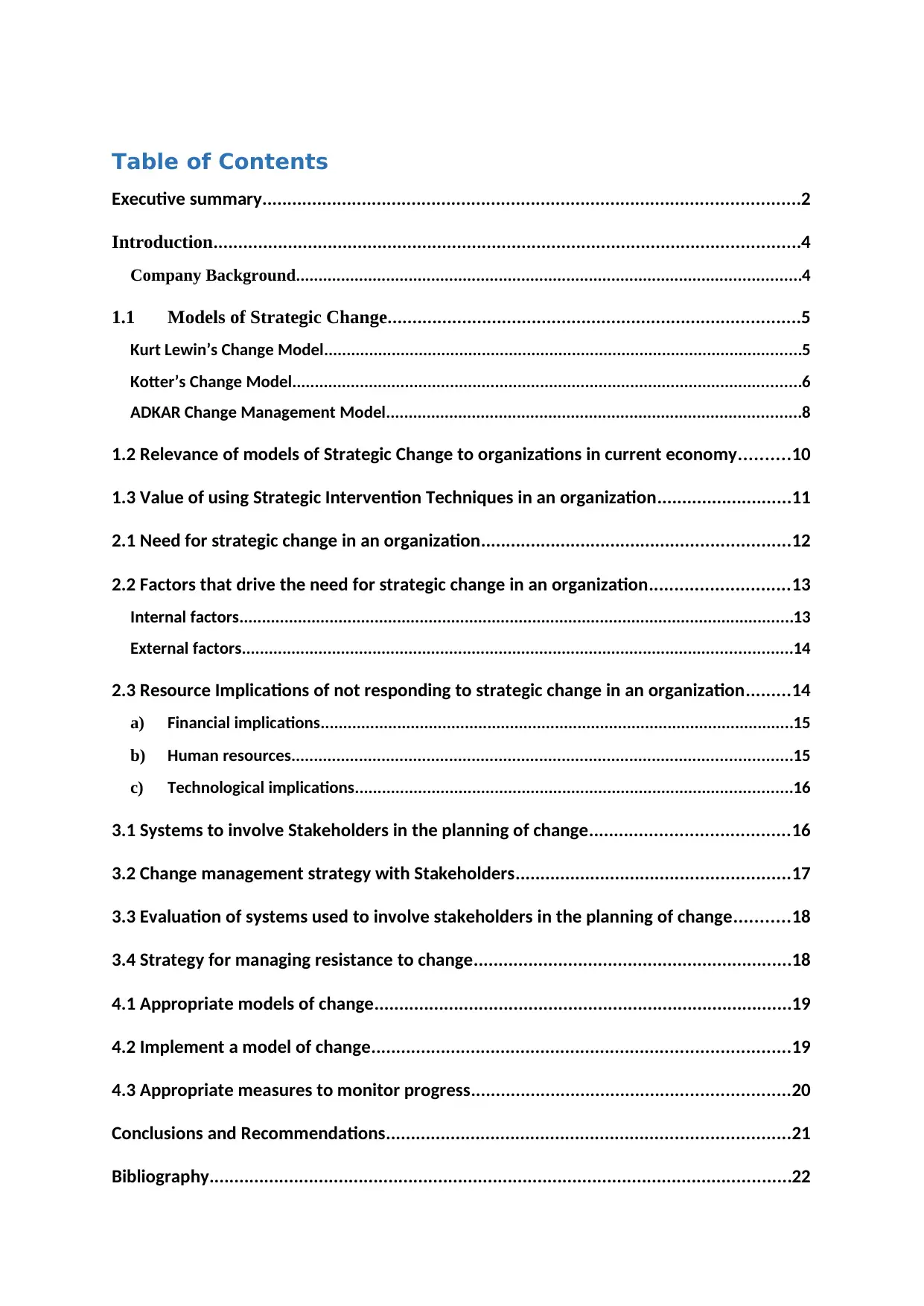
Table of Contents
Executive summary............................................................................................................2
Introduction......................................................................................................................4
Company Background................................................................................................................4
1.1 Models of Strategic Change...................................................................................5
Kurt Lewin’s Change Model..........................................................................................................5
Kotter’s Change Model.................................................................................................................6
ADKAR Change Management Model............................................................................................8
1.2 Relevance of models of Strategic Change to organizations in current economy..........10
1.3 Value of using Strategic Intervention Techniques in an organization...........................11
2.1 Need for strategic change in an organization..............................................................12
2.2 Factors that drive the need for strategic change in an organization............................13
Internal factors...........................................................................................................................13
External factors..........................................................................................................................14
2.3 Resource Implications of not responding to strategic change in an organization.........14
a) Financial implications.........................................................................................................15
b) Human resources...............................................................................................................15
c) Technological implications.................................................................................................16
3.1 Systems to involve Stakeholders in the planning of change........................................16
3.2 Change management strategy with Stakeholders.......................................................17
3.3 Evaluation of systems used to involve stakeholders in the planning of change...........18
3.4 Strategy for managing resistance to change................................................................18
4.1 Appropriate models of change....................................................................................19
4.2 Implement a model of change....................................................................................19
4.3 Appropriate measures to monitor progress................................................................20
Conclusions and Recommendations.................................................................................21
Bibliography.....................................................................................................................22
Executive summary............................................................................................................2
Introduction......................................................................................................................4
Company Background................................................................................................................4
1.1 Models of Strategic Change...................................................................................5
Kurt Lewin’s Change Model..........................................................................................................5
Kotter’s Change Model.................................................................................................................6
ADKAR Change Management Model............................................................................................8
1.2 Relevance of models of Strategic Change to organizations in current economy..........10
1.3 Value of using Strategic Intervention Techniques in an organization...........................11
2.1 Need for strategic change in an organization..............................................................12
2.2 Factors that drive the need for strategic change in an organization............................13
Internal factors...........................................................................................................................13
External factors..........................................................................................................................14
2.3 Resource Implications of not responding to strategic change in an organization.........14
a) Financial implications.........................................................................................................15
b) Human resources...............................................................................................................15
c) Technological implications.................................................................................................16
3.1 Systems to involve Stakeholders in the planning of change........................................16
3.2 Change management strategy with Stakeholders.......................................................17
3.3 Evaluation of systems used to involve stakeholders in the planning of change...........18
3.4 Strategy for managing resistance to change................................................................18
4.1 Appropriate models of change....................................................................................19
4.2 Implement a model of change....................................................................................19
4.3 Appropriate measures to monitor progress................................................................20
Conclusions and Recommendations.................................................................................21
Bibliography.....................................................................................................................22
⊘ This is a preview!⊘
Do you want full access?
Subscribe today to unlock all pages.

Trusted by 1+ million students worldwide
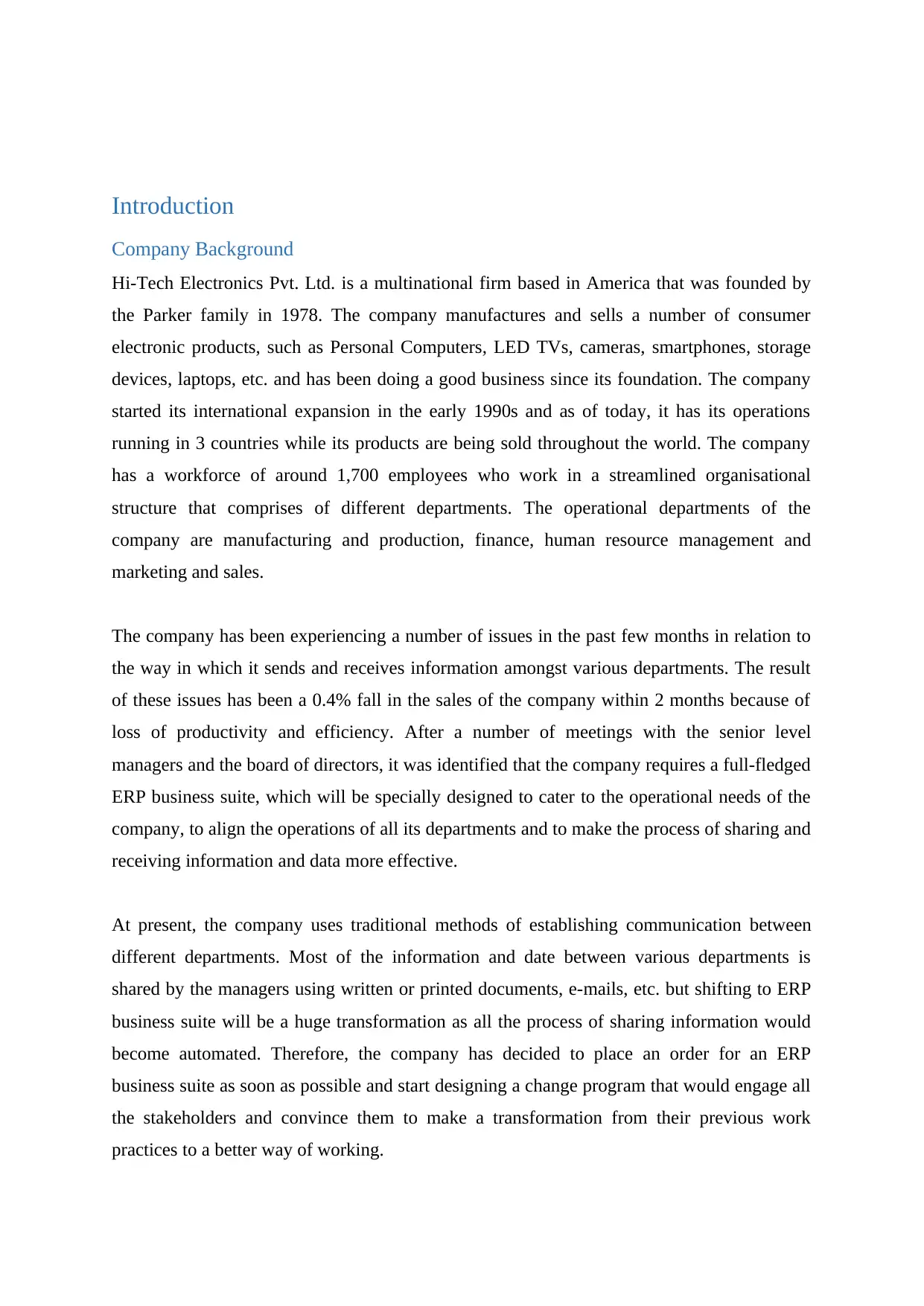
Introduction
Company Background
Hi-Tech Electronics Pvt. Ltd. is a multinational firm based in America that was founded by
the Parker family in 1978. The company manufactures and sells a number of consumer
electronic products, such as Personal Computers, LED TVs, cameras, smartphones, storage
devices, laptops, etc. and has been doing a good business since its foundation. The company
started its international expansion in the early 1990s and as of today, it has its operations
running in 3 countries while its products are being sold throughout the world. The company
has a workforce of around 1,700 employees who work in a streamlined organisational
structure that comprises of different departments. The operational departments of the
company are manufacturing and production, finance, human resource management and
marketing and sales.
The company has been experiencing a number of issues in the past few months in relation to
the way in which it sends and receives information amongst various departments. The result
of these issues has been a 0.4% fall in the sales of the company within 2 months because of
loss of productivity and efficiency. After a number of meetings with the senior level
managers and the board of directors, it was identified that the company requires a full-fledged
ERP business suite, which will be specially designed to cater to the operational needs of the
company, to align the operations of all its departments and to make the process of sharing and
receiving information and data more effective.
At present, the company uses traditional methods of establishing communication between
different departments. Most of the information and date between various departments is
shared by the managers using written or printed documents, e-mails, etc. but shifting to ERP
business suite will be a huge transformation as all the process of sharing information would
become automated. Therefore, the company has decided to place an order for an ERP
business suite as soon as possible and start designing a change program that would engage all
the stakeholders and convince them to make a transformation from their previous work
practices to a better way of working.
Company Background
Hi-Tech Electronics Pvt. Ltd. is a multinational firm based in America that was founded by
the Parker family in 1978. The company manufactures and sells a number of consumer
electronic products, such as Personal Computers, LED TVs, cameras, smartphones, storage
devices, laptops, etc. and has been doing a good business since its foundation. The company
started its international expansion in the early 1990s and as of today, it has its operations
running in 3 countries while its products are being sold throughout the world. The company
has a workforce of around 1,700 employees who work in a streamlined organisational
structure that comprises of different departments. The operational departments of the
company are manufacturing and production, finance, human resource management and
marketing and sales.
The company has been experiencing a number of issues in the past few months in relation to
the way in which it sends and receives information amongst various departments. The result
of these issues has been a 0.4% fall in the sales of the company within 2 months because of
loss of productivity and efficiency. After a number of meetings with the senior level
managers and the board of directors, it was identified that the company requires a full-fledged
ERP business suite, which will be specially designed to cater to the operational needs of the
company, to align the operations of all its departments and to make the process of sharing and
receiving information and data more effective.
At present, the company uses traditional methods of establishing communication between
different departments. Most of the information and date between various departments is
shared by the managers using written or printed documents, e-mails, etc. but shifting to ERP
business suite will be a huge transformation as all the process of sharing information would
become automated. Therefore, the company has decided to place an order for an ERP
business suite as soon as possible and start designing a change program that would engage all
the stakeholders and convince them to make a transformation from their previous work
practices to a better way of working.
Paraphrase This Document
Need a fresh take? Get an instant paraphrase of this document with our AI Paraphraser
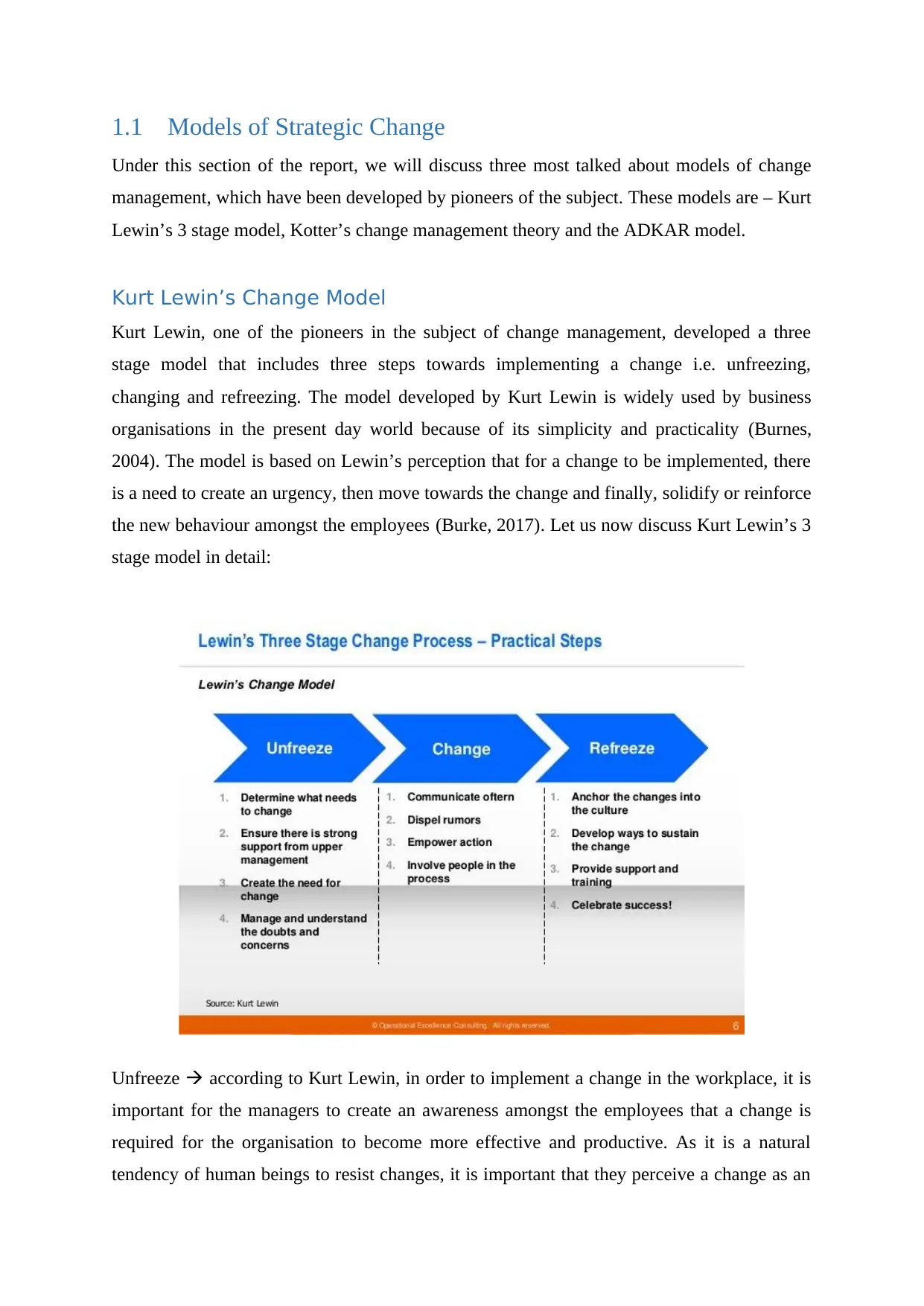
1.1 Models of Strategic Change
Under this section of the report, we will discuss three most talked about models of change
management, which have been developed by pioneers of the subject. These models are – Kurt
Lewin’s 3 stage model, Kotter’s change management theory and the ADKAR model.
Kurt Lewin’s Change Model
Kurt Lewin, one of the pioneers in the subject of change management, developed a three
stage model that includes three steps towards implementing a change i.e. unfreezing,
changing and refreezing. The model developed by Kurt Lewin is widely used by business
organisations in the present day world because of its simplicity and practicality (Burnes,
2004). The model is based on Lewin’s perception that for a change to be implemented, there
is a need to create an urgency, then move towards the change and finally, solidify or reinforce
the new behaviour amongst the employees (Burke, 2017). Let us now discuss Kurt Lewin’s 3
stage model in detail:
Unfreeze according to Kurt Lewin, in order to implement a change in the workplace, it is
important for the managers to create an awareness amongst the employees that a change is
required for the organisation to become more effective and productive. As it is a natural
tendency of human beings to resist changes, it is important that they perceive a change as an
Under this section of the report, we will discuss three most talked about models of change
management, which have been developed by pioneers of the subject. These models are – Kurt
Lewin’s 3 stage model, Kotter’s change management theory and the ADKAR model.
Kurt Lewin’s Change Model
Kurt Lewin, one of the pioneers in the subject of change management, developed a three
stage model that includes three steps towards implementing a change i.e. unfreezing,
changing and refreezing. The model developed by Kurt Lewin is widely used by business
organisations in the present day world because of its simplicity and practicality (Burnes,
2004). The model is based on Lewin’s perception that for a change to be implemented, there
is a need to create an urgency, then move towards the change and finally, solidify or reinforce
the new behaviour amongst the employees (Burke, 2017). Let us now discuss Kurt Lewin’s 3
stage model in detail:
Unfreeze according to Kurt Lewin, in order to implement a change in the workplace, it is
important for the managers to create an awareness amongst the employees that a change is
required for the organisation to become more effective and productive. As it is a natural
tendency of human beings to resist changes, it is important that they perceive a change as an
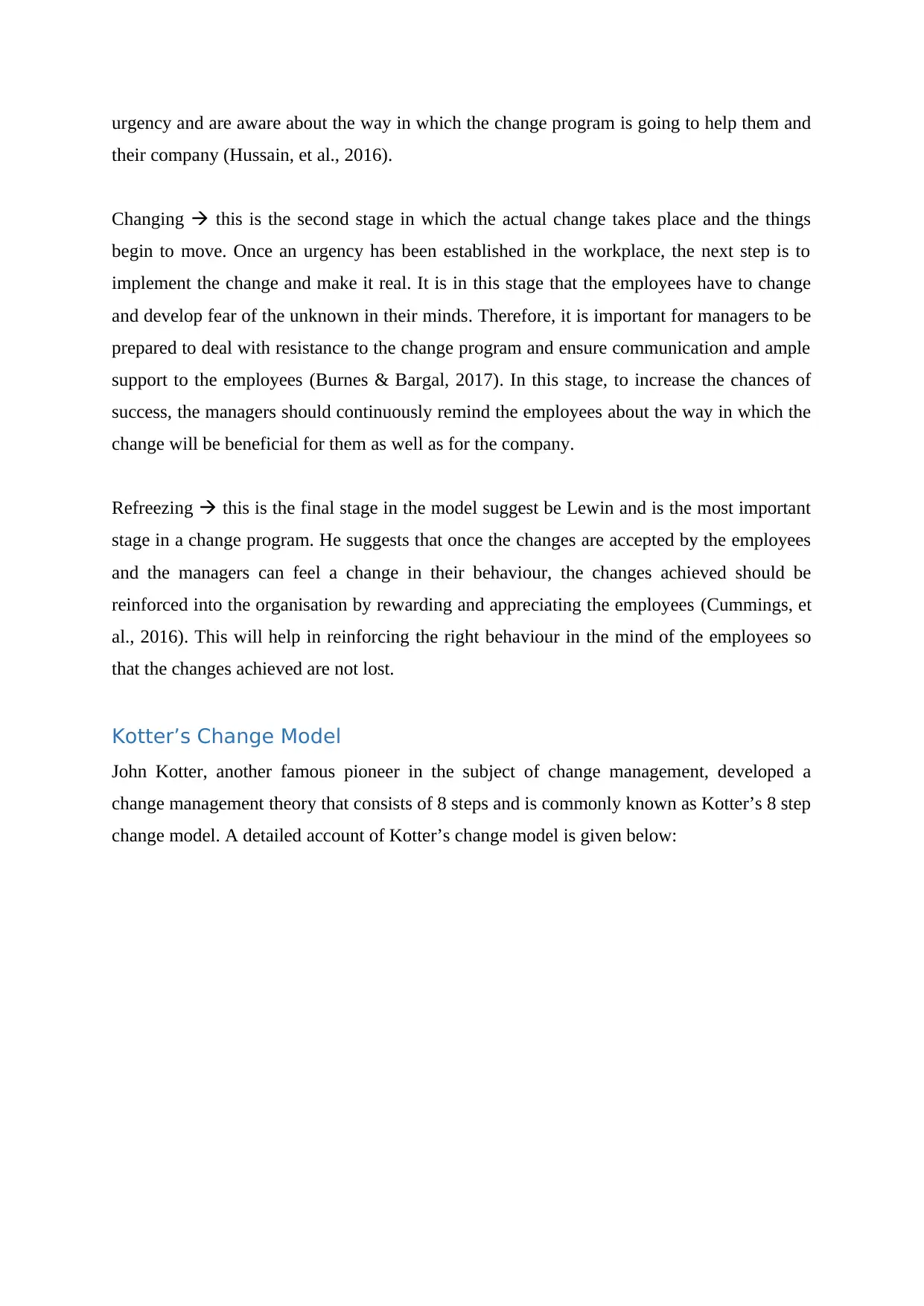
urgency and are aware about the way in which the change program is going to help them and
their company (Hussain, et al., 2016).
Changing this is the second stage in which the actual change takes place and the things
begin to move. Once an urgency has been established in the workplace, the next step is to
implement the change and make it real. It is in this stage that the employees have to change
and develop fear of the unknown in their minds. Therefore, it is important for managers to be
prepared to deal with resistance to the change program and ensure communication and ample
support to the employees (Burnes & Bargal, 2017). In this stage, to increase the chances of
success, the managers should continuously remind the employees about the way in which the
change will be beneficial for them as well as for the company.
Refreezing this is the final stage in the model suggest be Lewin and is the most important
stage in a change program. He suggests that once the changes are accepted by the employees
and the managers can feel a change in their behaviour, the changes achieved should be
reinforced into the organisation by rewarding and appreciating the employees (Cummings, et
al., 2016). This will help in reinforcing the right behaviour in the mind of the employees so
that the changes achieved are not lost.
Kotter’s Change Model
John Kotter, another famous pioneer in the subject of change management, developed a
change management theory that consists of 8 steps and is commonly known as Kotter’s 8 step
change model. A detailed account of Kotter’s change model is given below:
their company (Hussain, et al., 2016).
Changing this is the second stage in which the actual change takes place and the things
begin to move. Once an urgency has been established in the workplace, the next step is to
implement the change and make it real. It is in this stage that the employees have to change
and develop fear of the unknown in their minds. Therefore, it is important for managers to be
prepared to deal with resistance to the change program and ensure communication and ample
support to the employees (Burnes & Bargal, 2017). In this stage, to increase the chances of
success, the managers should continuously remind the employees about the way in which the
change will be beneficial for them as well as for the company.
Refreezing this is the final stage in the model suggest be Lewin and is the most important
stage in a change program. He suggests that once the changes are accepted by the employees
and the managers can feel a change in their behaviour, the changes achieved should be
reinforced into the organisation by rewarding and appreciating the employees (Cummings, et
al., 2016). This will help in reinforcing the right behaviour in the mind of the employees so
that the changes achieved are not lost.
Kotter’s Change Model
John Kotter, another famous pioneer in the subject of change management, developed a
change management theory that consists of 8 steps and is commonly known as Kotter’s 8 step
change model. A detailed account of Kotter’s change model is given below:
⊘ This is a preview!⊘
Do you want full access?
Subscribe today to unlock all pages.

Trusted by 1+ million students worldwide
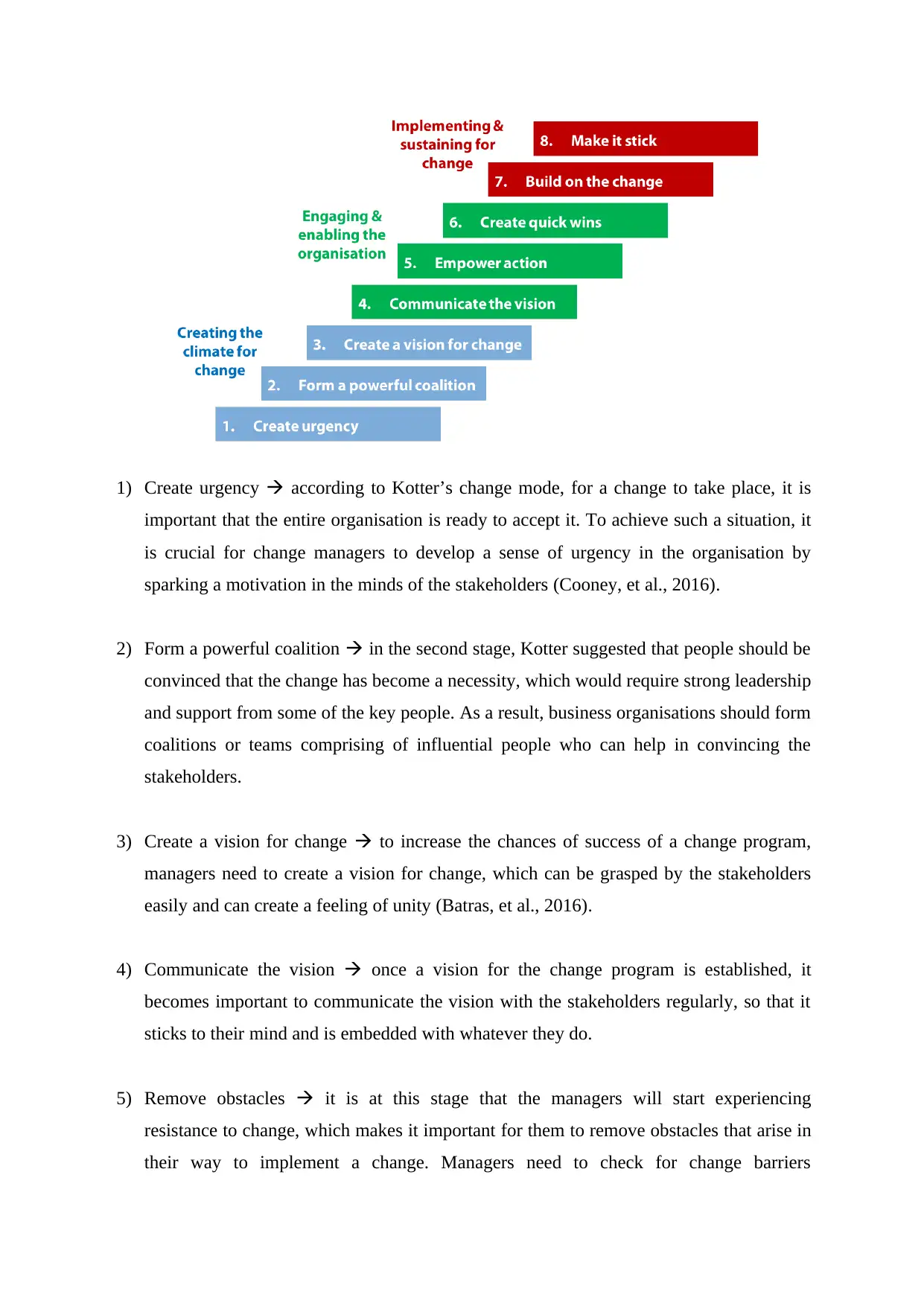
1) Create urgency according to Kotter’s change mode, for a change to take place, it is
important that the entire organisation is ready to accept it. To achieve such a situation, it
is crucial for change managers to develop a sense of urgency in the organisation by
sparking a motivation in the minds of the stakeholders (Cooney, et al., 2016).
2) Form a powerful coalition in the second stage, Kotter suggested that people should be
convinced that the change has become a necessity, which would require strong leadership
and support from some of the key people. As a result, business organisations should form
coalitions or teams comprising of influential people who can help in convincing the
stakeholders.
3) Create a vision for change to increase the chances of success of a change program,
managers need to create a vision for change, which can be grasped by the stakeholders
easily and can create a feeling of unity (Batras, et al., 2016).
4) Communicate the vision once a vision for the change program is established, it
becomes important to communicate the vision with the stakeholders regularly, so that it
sticks to their mind and is embedded with whatever they do.
5) Remove obstacles it is at this stage that the managers will start experiencing
resistance to change, which makes it important for them to remove obstacles that arise in
their way to implement a change. Managers need to check for change barriers
important that the entire organisation is ready to accept it. To achieve such a situation, it
is crucial for change managers to develop a sense of urgency in the organisation by
sparking a motivation in the minds of the stakeholders (Cooney, et al., 2016).
2) Form a powerful coalition in the second stage, Kotter suggested that people should be
convinced that the change has become a necessity, which would require strong leadership
and support from some of the key people. As a result, business organisations should form
coalitions or teams comprising of influential people who can help in convincing the
stakeholders.
3) Create a vision for change to increase the chances of success of a change program,
managers need to create a vision for change, which can be grasped by the stakeholders
easily and can create a feeling of unity (Batras, et al., 2016).
4) Communicate the vision once a vision for the change program is established, it
becomes important to communicate the vision with the stakeholders regularly, so that it
sticks to their mind and is embedded with whatever they do.
5) Remove obstacles it is at this stage that the managers will start experiencing
resistance to change, which makes it important for them to remove obstacles that arise in
their way to implement a change. Managers need to check for change barriers
Paraphrase This Document
Need a fresh take? Get an instant paraphrase of this document with our AI Paraphraser
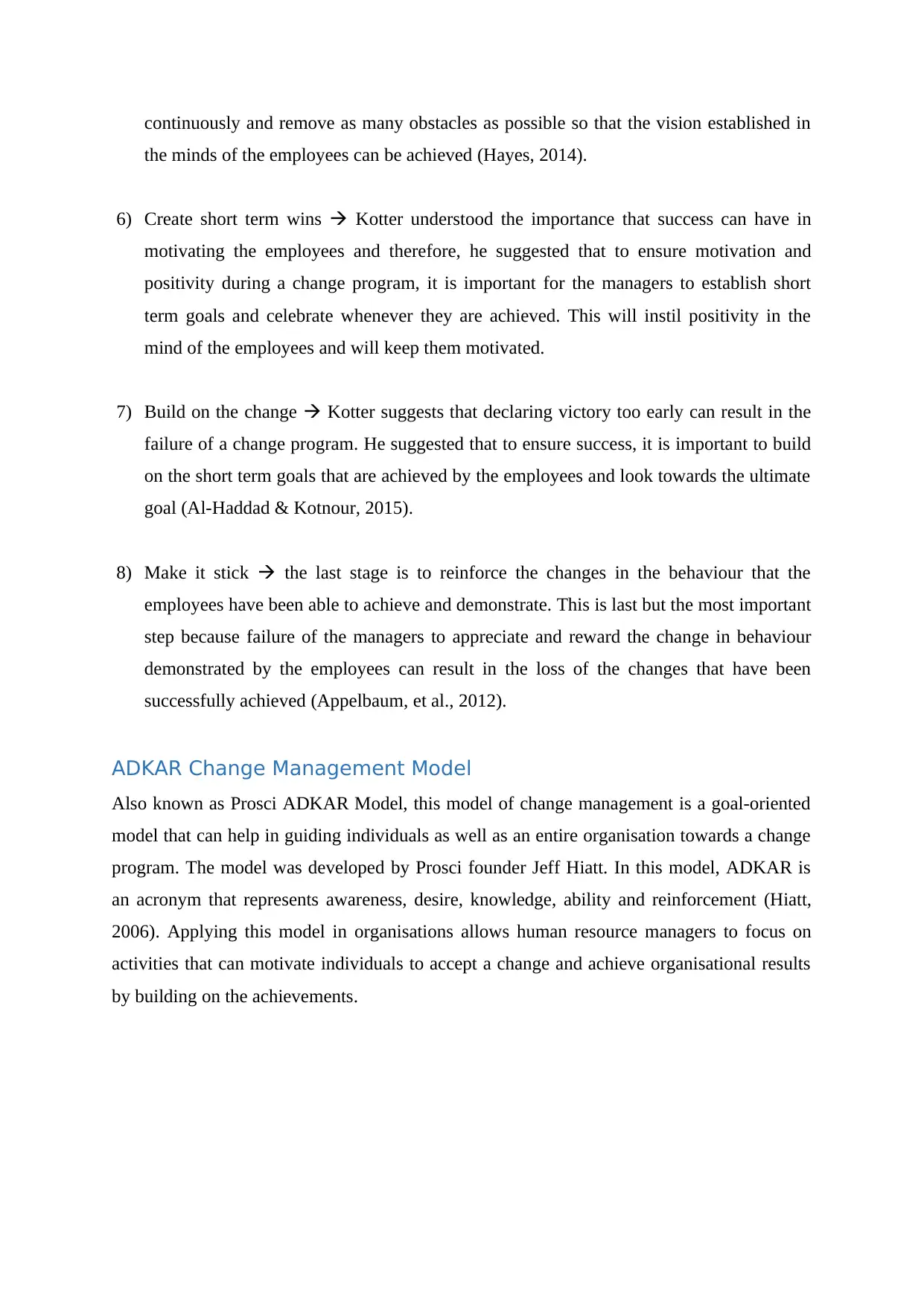
continuously and remove as many obstacles as possible so that the vision established in
the minds of the employees can be achieved (Hayes, 2014).
6) Create short term wins Kotter understood the importance that success can have in
motivating the employees and therefore, he suggested that to ensure motivation and
positivity during a change program, it is important for the managers to establish short
term goals and celebrate whenever they are achieved. This will instil positivity in the
mind of the employees and will keep them motivated.
7) Build on the change Kotter suggests that declaring victory too early can result in the
failure of a change program. He suggested that to ensure success, it is important to build
on the short term goals that are achieved by the employees and look towards the ultimate
goal (Al-Haddad & Kotnour, 2015).
8) Make it stick the last stage is to reinforce the changes in the behaviour that the
employees have been able to achieve and demonstrate. This is last but the most important
step because failure of the managers to appreciate and reward the change in behaviour
demonstrated by the employees can result in the loss of the changes that have been
successfully achieved (Appelbaum, et al., 2012).
ADKAR Change Management Model
Also known as Prosci ADKAR Model, this model of change management is a goal-oriented
model that can help in guiding individuals as well as an entire organisation towards a change
program. The model was developed by Prosci founder Jeff Hiatt. In this model, ADKAR is
an acronym that represents awareness, desire, knowledge, ability and reinforcement (Hiatt,
2006). Applying this model in organisations allows human resource managers to focus on
activities that can motivate individuals to accept a change and achieve organisational results
by building on the achievements.
the minds of the employees can be achieved (Hayes, 2014).
6) Create short term wins Kotter understood the importance that success can have in
motivating the employees and therefore, he suggested that to ensure motivation and
positivity during a change program, it is important for the managers to establish short
term goals and celebrate whenever they are achieved. This will instil positivity in the
mind of the employees and will keep them motivated.
7) Build on the change Kotter suggests that declaring victory too early can result in the
failure of a change program. He suggested that to ensure success, it is important to build
on the short term goals that are achieved by the employees and look towards the ultimate
goal (Al-Haddad & Kotnour, 2015).
8) Make it stick the last stage is to reinforce the changes in the behaviour that the
employees have been able to achieve and demonstrate. This is last but the most important
step because failure of the managers to appreciate and reward the change in behaviour
demonstrated by the employees can result in the loss of the changes that have been
successfully achieved (Appelbaum, et al., 2012).
ADKAR Change Management Model
Also known as Prosci ADKAR Model, this model of change management is a goal-oriented
model that can help in guiding individuals as well as an entire organisation towards a change
program. The model was developed by Prosci founder Jeff Hiatt. In this model, ADKAR is
an acronym that represents awareness, desire, knowledge, ability and reinforcement (Hiatt,
2006). Applying this model in organisations allows human resource managers to focus on
activities that can motivate individuals to accept a change and achieve organisational results
by building on the achievements.
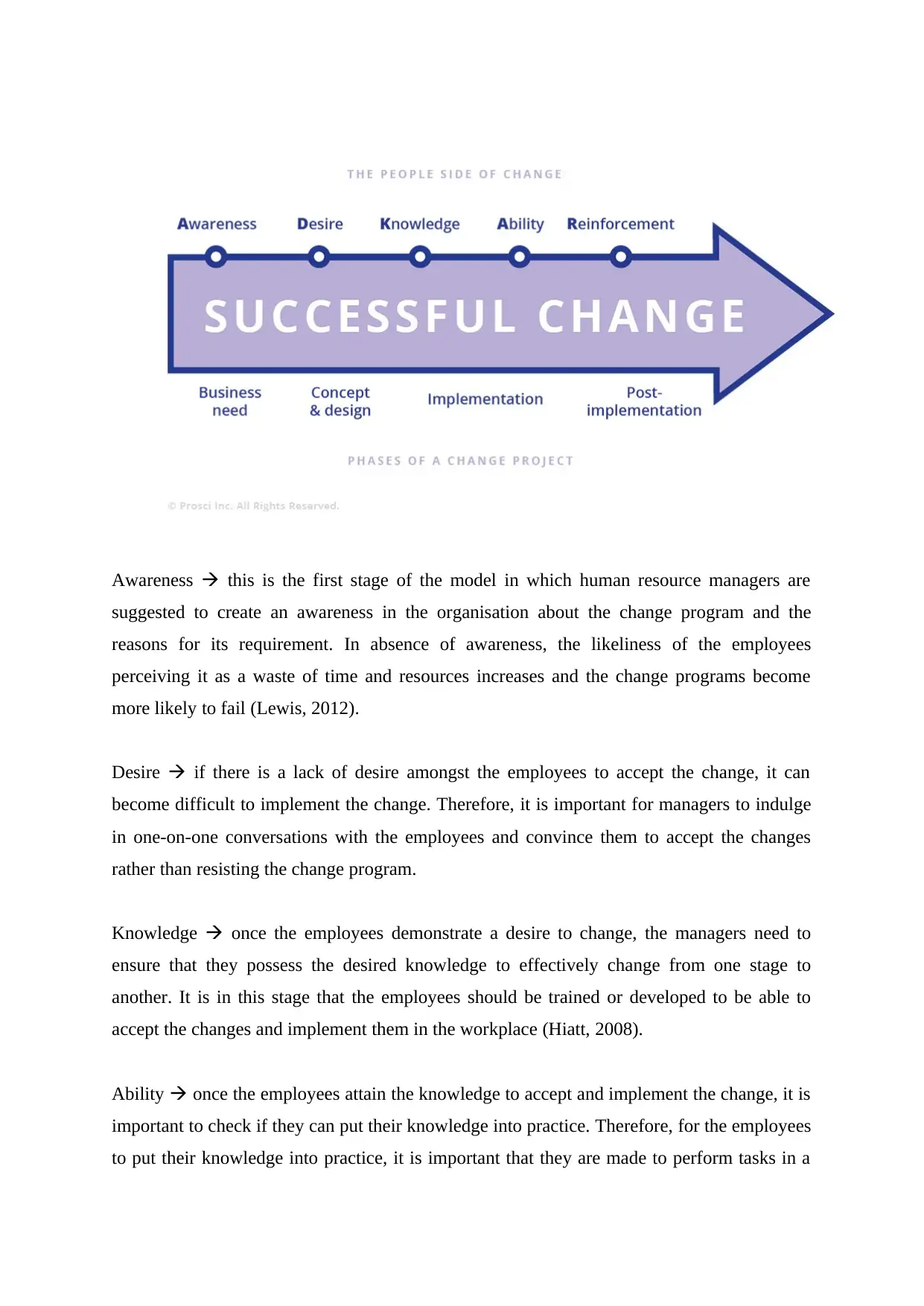
Awareness this is the first stage of the model in which human resource managers are
suggested to create an awareness in the organisation about the change program and the
reasons for its requirement. In absence of awareness, the likeliness of the employees
perceiving it as a waste of time and resources increases and the change programs become
more likely to fail (Lewis, 2012).
Desire if there is a lack of desire amongst the employees to accept the change, it can
become difficult to implement the change. Therefore, it is important for managers to indulge
in one-on-one conversations with the employees and convince them to accept the changes
rather than resisting the change program.
Knowledge once the employees demonstrate a desire to change, the managers need to
ensure that they possess the desired knowledge to effectively change from one stage to
another. It is in this stage that the employees should be trained or developed to be able to
accept the changes and implement them in the workplace (Hiatt, 2008).
Ability once the employees attain the knowledge to accept and implement the change, it is
important to check if they can put their knowledge into practice. Therefore, for the employees
to put their knowledge into practice, it is important that they are made to perform tasks in a
suggested to create an awareness in the organisation about the change program and the
reasons for its requirement. In absence of awareness, the likeliness of the employees
perceiving it as a waste of time and resources increases and the change programs become
more likely to fail (Lewis, 2012).
Desire if there is a lack of desire amongst the employees to accept the change, it can
become difficult to implement the change. Therefore, it is important for managers to indulge
in one-on-one conversations with the employees and convince them to accept the changes
rather than resisting the change program.
Knowledge once the employees demonstrate a desire to change, the managers need to
ensure that they possess the desired knowledge to effectively change from one stage to
another. It is in this stage that the employees should be trained or developed to be able to
accept the changes and implement them in the workplace (Hiatt, 2008).
Ability once the employees attain the knowledge to accept and implement the change, it is
important to check if they can put their knowledge into practice. Therefore, for the employees
to put their knowledge into practice, it is important that they are made to perform tasks in a
⊘ This is a preview!⊘
Do you want full access?
Subscribe today to unlock all pages.

Trusted by 1+ million students worldwide
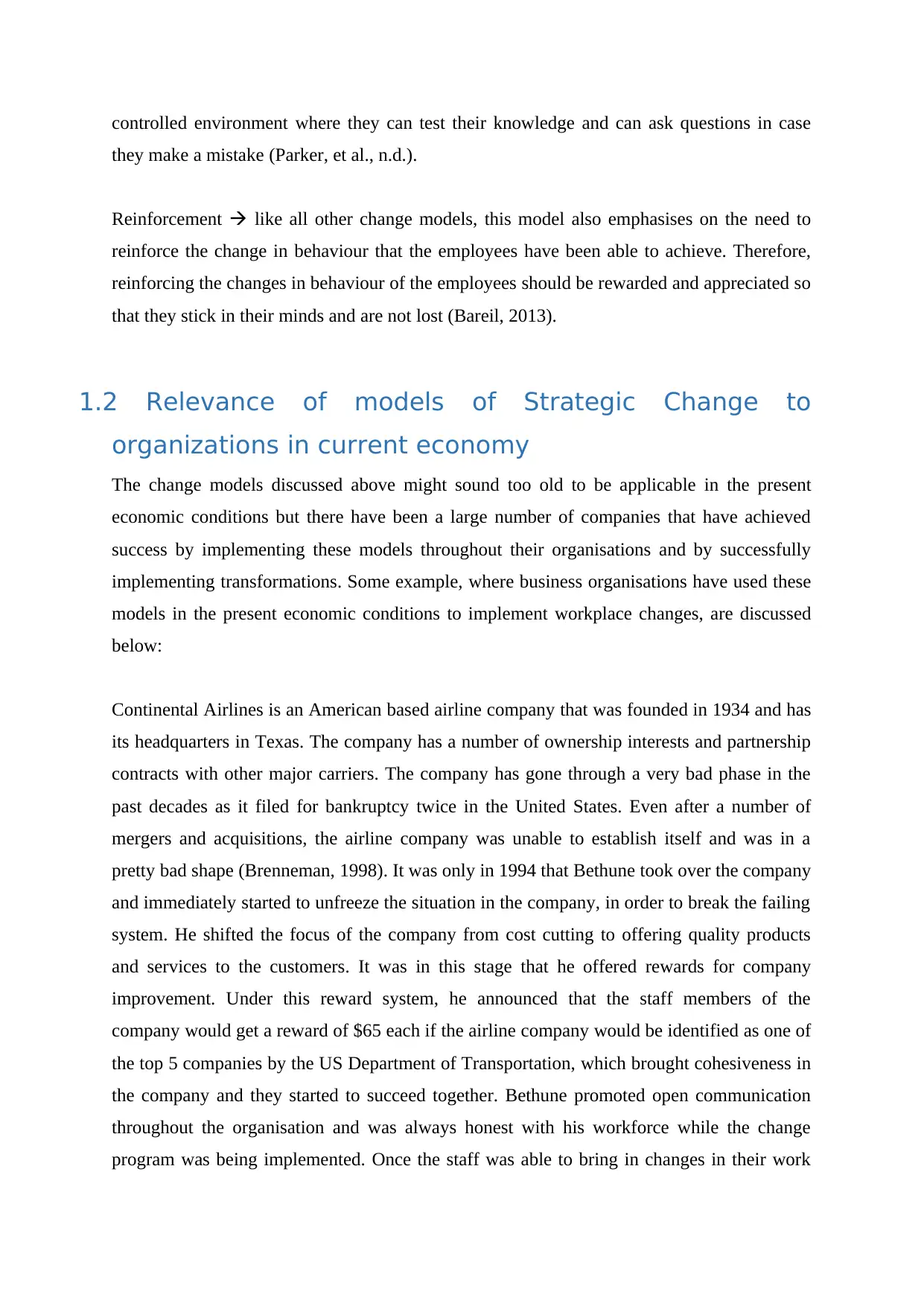
controlled environment where they can test their knowledge and can ask questions in case
they make a mistake (Parker, et al., n.d.).
Reinforcement like all other change models, this model also emphasises on the need to
reinforce the change in behaviour that the employees have been able to achieve. Therefore,
reinforcing the changes in behaviour of the employees should be rewarded and appreciated so
that they stick in their minds and are not lost (Bareil, 2013).
1.2 Relevance of models of Strategic Change to
organizations in current economy
The change models discussed above might sound too old to be applicable in the present
economic conditions but there have been a large number of companies that have achieved
success by implementing these models throughout their organisations and by successfully
implementing transformations. Some example, where business organisations have used these
models in the present economic conditions to implement workplace changes, are discussed
below:
Continental Airlines is an American based airline company that was founded in 1934 and has
its headquarters in Texas. The company has a number of ownership interests and partnership
contracts with other major carriers. The company has gone through a very bad phase in the
past decades as it filed for bankruptcy twice in the United States. Even after a number of
mergers and acquisitions, the airline company was unable to establish itself and was in a
pretty bad shape (Brenneman, 1998). It was only in 1994 that Bethune took over the company
and immediately started to unfreeze the situation in the company, in order to break the failing
system. He shifted the focus of the company from cost cutting to offering quality products
and services to the customers. It was in this stage that he offered rewards for company
improvement. Under this reward system, he announced that the staff members of the
company would get a reward of $65 each if the airline company would be identified as one of
the top 5 companies by the US Department of Transportation, which brought cohesiveness in
the company and they started to succeed together. Bethune promoted open communication
throughout the organisation and was always honest with his workforce while the change
program was being implemented. Once the staff was able to bring in changes in their work
they make a mistake (Parker, et al., n.d.).
Reinforcement like all other change models, this model also emphasises on the need to
reinforce the change in behaviour that the employees have been able to achieve. Therefore,
reinforcing the changes in behaviour of the employees should be rewarded and appreciated so
that they stick in their minds and are not lost (Bareil, 2013).
1.2 Relevance of models of Strategic Change to
organizations in current economy
The change models discussed above might sound too old to be applicable in the present
economic conditions but there have been a large number of companies that have achieved
success by implementing these models throughout their organisations and by successfully
implementing transformations. Some example, where business organisations have used these
models in the present economic conditions to implement workplace changes, are discussed
below:
Continental Airlines is an American based airline company that was founded in 1934 and has
its headquarters in Texas. The company has a number of ownership interests and partnership
contracts with other major carriers. The company has gone through a very bad phase in the
past decades as it filed for bankruptcy twice in the United States. Even after a number of
mergers and acquisitions, the airline company was unable to establish itself and was in a
pretty bad shape (Brenneman, 1998). It was only in 1994 that Bethune took over the company
and immediately started to unfreeze the situation in the company, in order to break the failing
system. He shifted the focus of the company from cost cutting to offering quality products
and services to the customers. It was in this stage that he offered rewards for company
improvement. Under this reward system, he announced that the staff members of the
company would get a reward of $65 each if the airline company would be identified as one of
the top 5 companies by the US Department of Transportation, which brought cohesiveness in
the company and they started to succeed together. Bethune promoted open communication
throughout the organisation and was always honest with his workforce while the change
program was being implemented. Once the staff was able to bring in changes in their work
Paraphrase This Document
Need a fresh take? Get an instant paraphrase of this document with our AI Paraphraser
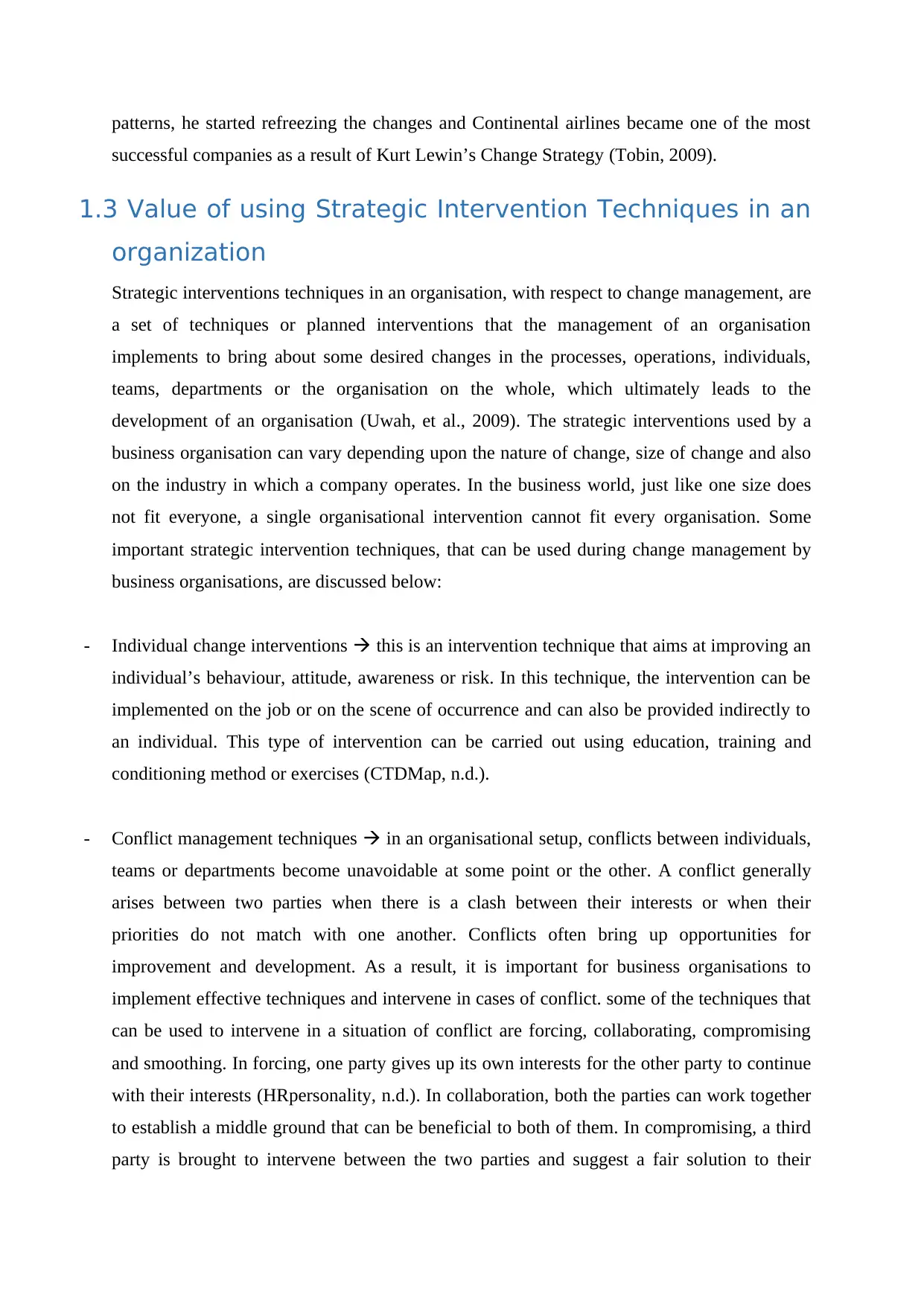
patterns, he started refreezing the changes and Continental airlines became one of the most
successful companies as a result of Kurt Lewin’s Change Strategy (Tobin, 2009).
1.3 Value of using Strategic Intervention Techniques in an
organization
Strategic interventions techniques in an organisation, with respect to change management, are
a set of techniques or planned interventions that the management of an organisation
implements to bring about some desired changes in the processes, operations, individuals,
teams, departments or the organisation on the whole, which ultimately leads to the
development of an organisation (Uwah, et al., 2009). The strategic interventions used by a
business organisation can vary depending upon the nature of change, size of change and also
on the industry in which a company operates. In the business world, just like one size does
not fit everyone, a single organisational intervention cannot fit every organisation. Some
important strategic intervention techniques, that can be used during change management by
business organisations, are discussed below:
- Individual change interventions this is an intervention technique that aims at improving an
individual’s behaviour, attitude, awareness or risk. In this technique, the intervention can be
implemented on the job or on the scene of occurrence and can also be provided indirectly to
an individual. This type of intervention can be carried out using education, training and
conditioning method or exercises (CTDMap, n.d.).
- Conflict management techniques in an organisational setup, conflicts between individuals,
teams or departments become unavoidable at some point or the other. A conflict generally
arises between two parties when there is a clash between their interests or when their
priorities do not match with one another. Conflicts often bring up opportunities for
improvement and development. As a result, it is important for business organisations to
implement effective techniques and intervene in cases of conflict. some of the techniques that
can be used to intervene in a situation of conflict are forcing, collaborating, compromising
and smoothing. In forcing, one party gives up its own interests for the other party to continue
with their interests (HRpersonality, n.d.). In collaboration, both the parties can work together
to establish a middle ground that can be beneficial to both of them. In compromising, a third
party is brought to intervene between the two parties and suggest a fair solution to their
successful companies as a result of Kurt Lewin’s Change Strategy (Tobin, 2009).
1.3 Value of using Strategic Intervention Techniques in an
organization
Strategic interventions techniques in an organisation, with respect to change management, are
a set of techniques or planned interventions that the management of an organisation
implements to bring about some desired changes in the processes, operations, individuals,
teams, departments or the organisation on the whole, which ultimately leads to the
development of an organisation (Uwah, et al., 2009). The strategic interventions used by a
business organisation can vary depending upon the nature of change, size of change and also
on the industry in which a company operates. In the business world, just like one size does
not fit everyone, a single organisational intervention cannot fit every organisation. Some
important strategic intervention techniques, that can be used during change management by
business organisations, are discussed below:
- Individual change interventions this is an intervention technique that aims at improving an
individual’s behaviour, attitude, awareness or risk. In this technique, the intervention can be
implemented on the job or on the scene of occurrence and can also be provided indirectly to
an individual. This type of intervention can be carried out using education, training and
conditioning method or exercises (CTDMap, n.d.).
- Conflict management techniques in an organisational setup, conflicts between individuals,
teams or departments become unavoidable at some point or the other. A conflict generally
arises between two parties when there is a clash between their interests or when their
priorities do not match with one another. Conflicts often bring up opportunities for
improvement and development. As a result, it is important for business organisations to
implement effective techniques and intervene in cases of conflict. some of the techniques that
can be used to intervene in a situation of conflict are forcing, collaborating, compromising
and smoothing. In forcing, one party gives up its own interests for the other party to continue
with their interests (HRpersonality, n.d.). In collaboration, both the parties can work together
to establish a middle ground that can be beneficial to both of them. In compromising, a third
party is brought to intervene between the two parties and suggest a fair solution to their
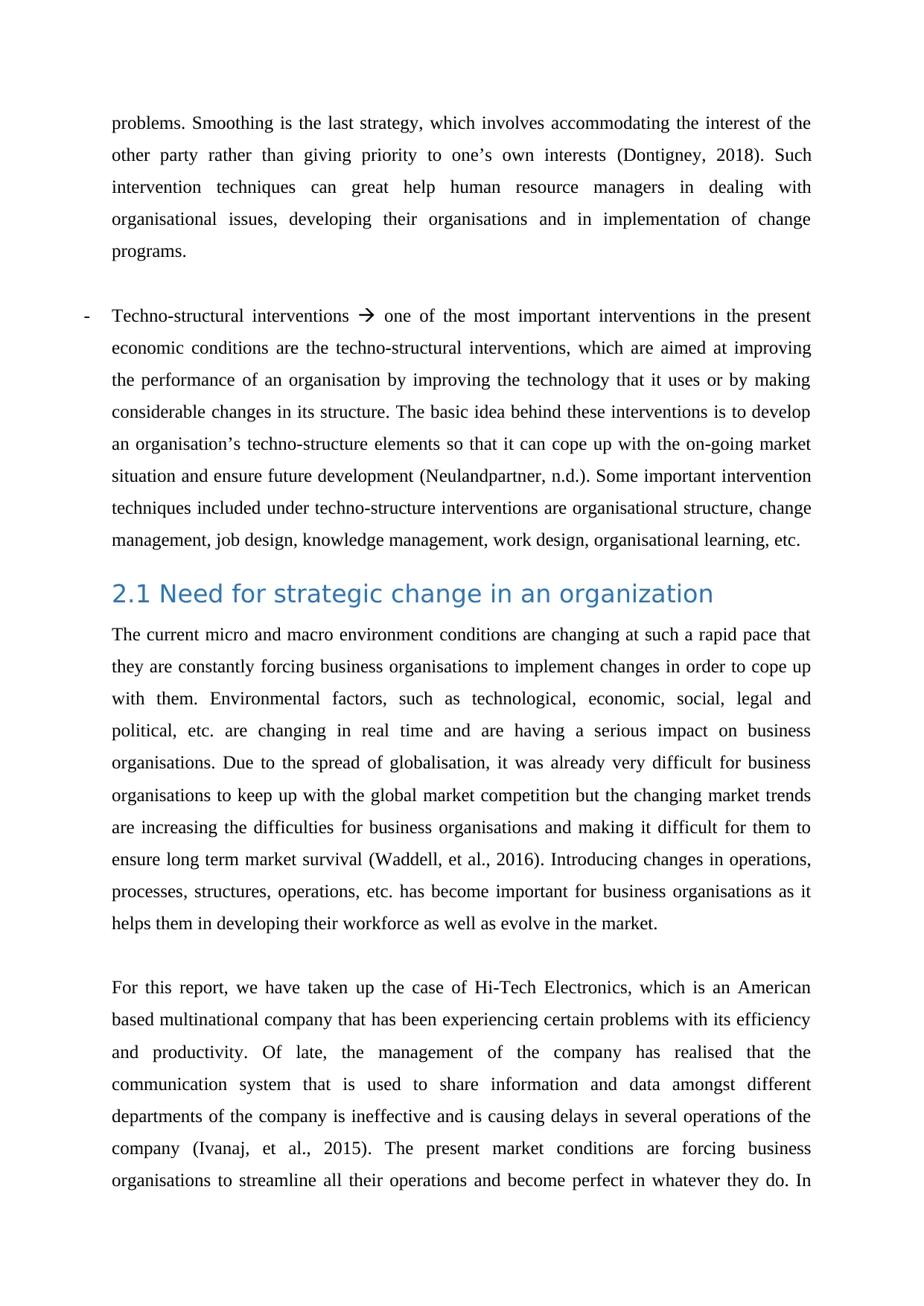
problems. Smoothing is the last strategy, which involves accommodating the interest of the
other party rather than giving priority to one’s own interests (Dontigney, 2018). Such
intervention techniques can great help human resource managers in dealing with
organisational issues, developing their organisations and in implementation of change
programs.
- Techno-structural interventions one of the most important interventions in the present
economic conditions are the techno-structural interventions, which are aimed at improving
the performance of an organisation by improving the technology that it uses or by making
considerable changes in its structure. The basic idea behind these interventions is to develop
an organisation’s techno-structure elements so that it can cope up with the on-going market
situation and ensure future development (Neulandpartner, n.d.). Some important intervention
techniques included under techno-structure interventions are organisational structure, change
management, job design, knowledge management, work design, organisational learning, etc.
2.1 Need for strategic change in an organization
The current micro and macro environment conditions are changing at such a rapid pace that
they are constantly forcing business organisations to implement changes in order to cope up
with them. Environmental factors, such as technological, economic, social, legal and
political, etc. are changing in real time and are having a serious impact on business
organisations. Due to the spread of globalisation, it was already very difficult for business
organisations to keep up with the global market competition but the changing market trends
are increasing the difficulties for business organisations and making it difficult for them to
ensure long term market survival (Waddell, et al., 2016). Introducing changes in operations,
processes, structures, operations, etc. has become important for business organisations as it
helps them in developing their workforce as well as evolve in the market.
For this report, we have taken up the case of Hi-Tech Electronics, which is an American
based multinational company that has been experiencing certain problems with its efficiency
and productivity. Of late, the management of the company has realised that the
communication system that is used to share information and data amongst different
departments of the company is ineffective and is causing delays in several operations of the
company (Ivanaj, et al., 2015). The present market conditions are forcing business
organisations to streamline all their operations and become perfect in whatever they do. In
other party rather than giving priority to one’s own interests (Dontigney, 2018). Such
intervention techniques can great help human resource managers in dealing with
organisational issues, developing their organisations and in implementation of change
programs.
- Techno-structural interventions one of the most important interventions in the present
economic conditions are the techno-structural interventions, which are aimed at improving
the performance of an organisation by improving the technology that it uses or by making
considerable changes in its structure. The basic idea behind these interventions is to develop
an organisation’s techno-structure elements so that it can cope up with the on-going market
situation and ensure future development (Neulandpartner, n.d.). Some important intervention
techniques included under techno-structure interventions are organisational structure, change
management, job design, knowledge management, work design, organisational learning, etc.
2.1 Need for strategic change in an organization
The current micro and macro environment conditions are changing at such a rapid pace that
they are constantly forcing business organisations to implement changes in order to cope up
with them. Environmental factors, such as technological, economic, social, legal and
political, etc. are changing in real time and are having a serious impact on business
organisations. Due to the spread of globalisation, it was already very difficult for business
organisations to keep up with the global market competition but the changing market trends
are increasing the difficulties for business organisations and making it difficult for them to
ensure long term market survival (Waddell, et al., 2016). Introducing changes in operations,
processes, structures, operations, etc. has become important for business organisations as it
helps them in developing their workforce as well as evolve in the market.
For this report, we have taken up the case of Hi-Tech Electronics, which is an American
based multinational company that has been experiencing certain problems with its efficiency
and productivity. Of late, the management of the company has realised that the
communication system that is used to share information and data amongst different
departments of the company is ineffective and is causing delays in several operations of the
company (Ivanaj, et al., 2015). The present market conditions are forcing business
organisations to streamline all their operations and become perfect in whatever they do. In
⊘ This is a preview!⊘
Do you want full access?
Subscribe today to unlock all pages.

Trusted by 1+ million students worldwide
1 out of 25
Related Documents
Your All-in-One AI-Powered Toolkit for Academic Success.
+13062052269
info@desklib.com
Available 24*7 on WhatsApp / Email
![[object Object]](/_next/static/media/star-bottom.7253800d.svg)
Unlock your academic potential
Copyright © 2020–2025 A2Z Services. All Rights Reserved. Developed and managed by ZUCOL.





